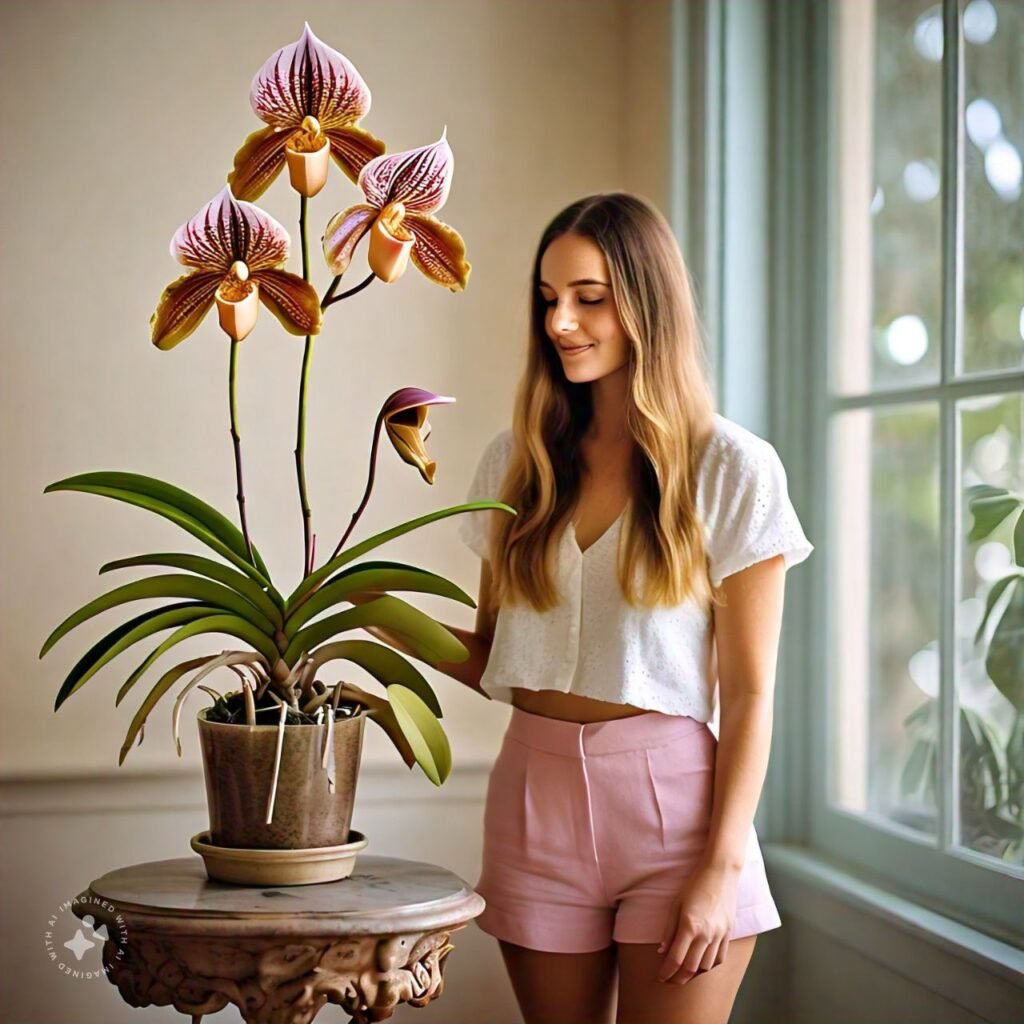United States (USA)

The Lady’s Slipper Orchid is often associated with the Eastern United States, where it is found in the wild. The most well-known species is the Pink Lady’s Slipper (Cypripedium acaule), which has been used historically by Native Americans for medicinal purposes. The species was widely admired during the 19th century when orchid collecting was at its peak.
Due to habitat loss and over-collection, many species of Lady’s Slippers in the U.S. are now protected.
2. Canada
In Canada, Lady’s Slipper Orchids are primarily found in the provinces of Ontario, Quebec, and the Maritime provinces. The Showy Lady’s Slipper (Cypripedium reginae) is particularly famous and was a favorite among early European settlers. This orchid is celebrated in Canadian culture and often featured in conservation efforts.
The orchid is protected under provincial laws due to its declining numbers in the wild.

3. United Kingdom

The Lady’s Slipper Orchid (Cypripedium calceolus) is one of the rarest wildflowers in the UK. It was nearly driven to extinction in the 20th century due to over-collection and habitat destruction. Once thought to be extinct, it was rediscovered in the 1930s and has since been the focus of intensive conservation efforts.
The orchid is legally protected, and its location in the wild is kept secret to prevent poaching.
4. Germany
In Germany, the Lady’s Slipper Orchid is known as “Frauenschuh.” It has a long history of being admired in European botany. The plant grows naturally in calcareous soils and is found in various regions, including the Bavarian Alps. It has been a symbol of beauty and rarity in German culture.
The species is protected under German law, and its habitats are closely monitored.

5. China

China is home to a variety of Lady’s Slipper Orchids, including Paphiopedilum and Cypripedium species. These orchids have been cultivated and admired for centuries, particularly during the Tang and Song dynasties. They are often associated with elegance and have been featured in traditional Chinese art and literature.
Due to the high demand for these orchids, many species are now protected, and cultivation is encouraged to reduce pressure on wild populations.
6. Japan
In Japan, the Lady’s Slipper Orchid, particularly Cypripedium japonicum, has been part of the native flora for centuries. These orchids are celebrated in Japanese horticulture and are often featured in traditional gardens. They are associated with purity and simplicity in Japanese culture.
Over-collection and habitat loss have led to the decline of native populations, prompting conservation efforts.

7. Taiwan

Taiwan is known for its rich diversity of orchids, including several species of Lady’s Slippers (Paphiopedilum). These orchids are an integral part of the island’s horticultural heritage and are often displayed in flower shows and cultural festivals.
Taiwan has implemented strict conservation laws to protect its native orchid species from extinction.
8. Nepal
Nepal is home to several species of Lady’s Slipper Orchids, including Paphiopedilum fairrieanum, which is highly prized by orchid enthusiasts. These orchids grow in the wild in the Himalayan region and have been collected for medicinal and ornamental purposes for centuries.
Due to their rarity, these orchids are now protected, and efforts are being made to conserve their natural habitats.

9. India

In India, Lady’s Slipper Orchids, especially Paphiopedilum druryi and Paphiopedilum fairrieanum, are found in the Eastern Himalayas and the Western Ghats. These orchids have been traditionally used in Ayurveda and are admired for their striking beauty.
Many species are now listed as endangered due to over-collection and habitat loss, leading to increased conservation efforts.
10. Bhutan
Bhutan, with its rich biodiversity, is home to several species of Lady’s Slipper Orchids. These orchids are revered in Bhutanese culture and are often found in high-altitude forests.
The government of Bhutan has implemented measures to protect these orchids, focusing on sustainable conservation practices.

11. Russia

In Russia, the Lady’s Slipper Orchid is found primarily in the Ural Mountains and Siberia. Cypripedium calceolus is the most widespread species, known for its resilience in cold climates. It has been a subject of interest in Russian botanical studies since the 19th century.
These orchids are protected under Russian environmental laws, particularly in nature reserves and national parks.
12. Mexico
Mexico is home to several species of Cypripedium orchids, particularly in the mountainous regions. These orchids have been admired for their exotic appearance and were collected extensively during the 19th century.
Due to over-collection and habitat destruction, these orchids are now rare in the wild, and conservation efforts are in place.

13. Australia

Australia is home to several species of Lady’s Slipper Orchids, particularly in the genera Pterostylis and Diuris, which are sometimes referred to as the “Australian Lady’s Slipper.” These orchids are native to various parts of the country and have been used in Aboriginal medicine.
Many species are protected due to their rarity and the ongoing threat from habitat loss.
14. Papua New Guinea
Papua New Guinea is a hotspot for orchid diversity, including species of Paphiopedilum. These orchids are prized for their unique appearance and have been traditionally used in local cultural practices.
With increasing deforestation, many species are now endangered, leading to conservation programs aimed at preserving the unique flora of the region.

15. Vietnam

Vietnam is home to several species of Paphiopedilum, which are highly sought after by orchid collectors. These orchids have been traditionally used in Vietnamese herbal medicine and are admired for their beauty.
Many species are now critically endangered, and efforts are being made to cultivate these orchids to prevent their extinction in the wild.
Rare Beauty: The Lady’s Slipper Orchid is known for its unique, slipper-shaped pouch, which is actually a modified petal. This distinctive shape traps insects, helping in pollination. Some species are extremely rare and highly sought after by orchid enthusiasts.
Varied Colors: Lady’s Slipper Orchids come in a variety of colors, including pink, yellow, white, and purple. The vibrant hues attract pollinators, while the intricate patterns on the flowers guide insects toward the nectar, ensuring the plant’s reproductive success.
Endangered Status: Several species of Lady’s Slipper Orchids are endangered due to habitat loss and over-collection. These orchids are protected by law in many regions, making it illegal to pick or disturb them in the wild, contributing to their conservation efforts.

Long Lifespan: Lady’s Slipper Orchids have an impressively long lifespan, often living for several decades. However, they take years to mature and produce flowers, with some species requiring up to 16 years before blooming for the first time.

Symbiotic Relationships: These orchids rely on a symbiotic relationship with fungi in the soil for germination. The fungi provide essential nutrients to the orchid’s seeds, which lack the necessary food reserves to grow independently, making the plant dependent on this unique partnership.
Diverse Habitat: Lady’s Slipper Orchids thrive in various habitats, from woodlands to bogs. Each species is adapted to specific environmental conditions, such as light, moisture, and soil type, making their conservation complex as they require the preservation of their natural habitats.
Pollination Strategy: The slipper-shaped pouch of the Lady’s Slipper Orchid traps insects temporarily. As the insect struggles to escape, it brushes against the flower’s reproductive parts, transferring pollen in the process. This clever design increases the likelihood of successful pollination.
Historical Significance: Native American tribes used the roots of some Lady’s Slipper Orchid species for medicinal purposes, treating ailments such as nervousness, toothaches, and muscle spasms. This historical use highlights the plant’s significance in traditional herbal medicine.
Slow Growth: Lady’s Slipper Orchids are notoriously slow-growing. After germination, the plant may take several years to develop its first leaves, and even longer to produce flowers. This slow growth contributes to their rarity and makes them challenging to cultivate.

Epiphytic Species: While most Lady’s Slipper Orchids grow in the ground, some species are epiphytic, meaning they grow on trees or rocks. These epiphytic orchids derive moisture and nutrients from the air and rain, rather than from the soil, showcasing their adaptability.

Cultural Symbolism: In some cultures, Lady’s Slipper Orchids are symbols of elegance, femininity, and beauty. The flower’s delicate appearance and rarity have inspired poets, artists, and gardeners alike, making it a beloved subject in various forms of art.
Challenging Cultivation: Cultivating Lady’s Slipper Orchids is notoriously difficult, even for experienced gardeners. They require specific conditions, such as precise humidity levels, well-drained soil, and indirect light. Their sensitivity to environmental changes makes them a challenging, yet rewarding, plant to grow.
Winter Dormancy: Many Lady’s Slipper Orchids undergo a period of dormancy during the winter months. During this time, the plant conserves energy and prepares for the next growing season. Proper care during dormancy is crucial for the plant’s health and future blooming.
Global Distribution: Lady’s Slipper Orchids are found on every continent except Antarctica. Their wide distribution includes North America, Europe, and Asia, where different species have evolved to adapt to various climates, from temperate forests to tropical regions.
Hybridization: Orchid enthusiasts have successfully hybridized different species of Lady’s Slipper Orchids, creating unique varieties with new color combinations and patterns. These hybrids are popular in the horticultural trade, offering a broader range of options for collectors and gardeners.

Sensitive Roots: The roots of Lady’s Slipper Orchids are highly sensitive and should not be disturbed. When transplanting or repotting, extreme care is required to avoid damaging the roots, as even minor disturbances can hinder the plant’s growth or lead to its demise.

Mythical Associations: Lady’s Slipper Orchids have been associated with various myths and legends. In Europe, the plant was believed to be the slipper of a woodland fairy, adding an element of mystique and enchantment to its already captivating appearance.
Taxonomic Diversity: The Lady’s Slipper Orchid belongs to the subfamily Cypripedioideae within the Orchidaceae family. This subfamily includes five genera: Cypripedium, Paphiopedilum, Phragmipedium, Mexipedium, and Selenipedium, each with its own distinct characteristics and native regions.
Unique Leaf Structure: The leaves of Lady’s Slipper Orchids are typically broad and leathery, arranged in a rosette at the base of the plant. Some species have mottled leaves, adding an extra layer of visual interest to the plant, even when it’s not in bloom.
Climate Adaptation: Lady’s Slipper Orchids are highly adaptable to different climates. Some species can withstand harsh, cold winters, while others thrive in the humid tropics. This adaptability has enabled the orchids to colonize diverse environments across the globe.
Flower Longevity: The blooms of Lady’s Slipper Orchids are long-lasting, often remaining vibrant for several weeks. This extended flowering period makes them a favorite among gardeners and floral designers, as the flowers provide a prolonged display of beauty.

Fungal Dependency: The seeds of Lady’s Slipper Orchids are tiny and lack endosperm, making them dependent on mycorrhizal fungi for germination. The fungi provide essential nutrients, helping the seed to develop into a seedling, a unique relationship vital to the orchid’s survival.
Orchid Family Member: Lady’s Slipper Orchids are part of the Orchidaceae family, one of the largest and most diverse plant families in the world. This family includes over 25,000 species, with Lady’s Slippers being among the most distinctive and recognized due to their unique flower shape.
Cultivated Varieties: Due to their beauty, many cultivated varieties of Lady’s Slipper Orchids have been developed. These varieties are often bred for specific traits, such as flower size, color, and ease of cultivation, making them more accessible to orchid enthusiasts.
Long Blooming Cycle: After blooming, Lady’s Slipper Orchids can take several years before flowering again. The plant invests significant energy into each bloom, making the flowering event a rare and eagerly anticipated occurrence for those who cultivate these orchids.
Sensitive to Pollution: Lady’s Slipper Orchids are sensitive to environmental pollution, including air and water quality. Pollutants can negatively impact their growth and survival, making them indicators of environmental health in their native habitats.
Mimicry in Nature: Some species of Lady’s Slipper Orchids use mimicry to attract pollinators. Their flowers may resemble the appearance or scent of certain insects, tricking them into visiting the flower and aiding in pollination without offering any nectar in return.
Protected by Law: Due to their rarity and ecological importance, many species of Lady’s Slipper Orchids are protected by law. In several countries, it is illegal to pick, dig up, or sell these orchids without special permits, ensuring their survival in the wild.
Adaptation to Light: Lady’s Slipper Orchids have adapted to a range of light conditions, from deep shade in forests to dappled sunlight in more open habitats. Understanding the light requirements of each species is crucial for successful cultivation and conservation efforts.
Ecological Role: Lady’s Slipper Orchids play an essential role in their ecosystems, particularly in terms of their relationships with pollinators and fungi. By maintaining these relationships, they contribute to the overall health and biodiversity of their natural environments.
Lady’s Slipper Orchids thrive in a well-draining, moisture-retentive soil mix. The best mix includes a blend of pine bark, perlite, and sphagnum moss. This combination provides the perfect balance of aeration, drainage, and moisture retention for healthy orchid growth.
Water Lady’s Slipper Orchids once a week, ensuring the soil stays moist but not waterlogged. Use distilled or rainwater to avoid mineral buildup. Adjust watering frequency depending on the humidity and temperature of your growing environment.
Lady’s Slipper Orchids prefer bright, indirect light. Place them near an east-facing window or provide filtered light to prevent direct sun exposure, which can scorch the leaves. Ensure they receive at least 12-14 hours of light daily.
Fertilize Lady’s Slipper Orchids every two weeks during the growing season with a balanced, water-soluble orchid fertilizer diluted to half strength. Reduce feeding to once a month during the dormant season to prevent root burn and nutrient buildup.
Lady’s Slipper Orchids thrive in a temperature range of 65-75°F (18-24°C) during the day and slightly cooler at night. Avoid exposing them to temperatures below 55°F (13°C) as they are sensitive to cold and may experience stunted growth.
Increase humidity for Lady’s Slipper Orchids by placing a humidity tray filled with water and pebbles under the pot, misting the plants daily, or using a humidifier. Maintain humidity levels around 50-70% for optimal growth and flower production.
Repot Lady’s Slipper Orchids every two years, ideally in the spring after blooming. Use a fresh orchid mix and a slightly larger pot if needed. Repotting encourages healthy root development and provides the plant with fresh nutrients.
Prevent pests and diseases by maintaining proper air circulation, avoiding overwatering, and inspecting plants regularly. Use insecticidal soap or neem oil to treat common pests like aphids and mealybugs. Ensure the soil mix is sterile to avoid fungal infections.
Common signs of stress in Lady’s Slipper Orchids include yellowing leaves, wilting, and reduced flowering. These symptoms often result from improper watering, insufficient light, or low humidity. Address these issues promptly to restore the plant’s health.
Encourage blooming by providing consistent care, including proper light, humidity, and temperature. Ensure the orchid receives enough light, reduce nighttime temperatures slightly during fall, and use a bloom-boosting fertilizer in the weeks leading up to the flowering season.
What is a Lady’s Slipper Orchid?
The Lady’s Slipper Orchid is a unique flowering plant known for its slipper-shaped pouch. It belongs to the genus Cypripedium and is admired for its unusual and intricate flowers.
Where do Lady’s Slipper Orchids grow naturally?
Lady’s Slipper Orchids are native to temperate regions of North America, Europe, and Asia. They typically grow in shaded, moist woodland areas with rich, well-drained soil.
Why are Lady’s Slipper Orchids rare?
Lady’s Slipper Orchids are rare due to habitat loss, over-collection, and their specific growing conditions. They require precise environmental factors to thrive, making them difficult to cultivate.
How do you care for a Lady’s Slipper Orchid?
Provide well-drained, slightly acidic soil, moderate humidity, and indirect sunlight. Water regularly, ensuring the soil remains moist but not waterlogged. Avoid disturbing the roots.
Can Lady’s Slipper Orchids be grown indoors?
Yes, they can be grown indoors if provided with proper conditions, such as filtered light, high humidity, and well-draining potting mix. Avoid direct sunlight and keep them cool.
What is the lifespan of a Lady’s Slipper Orchid?
In the wild, Lady’s Slipper Orchids can live for several decades. When cultivated properly, they can thrive for many years, though they require specific care to maintain health.
Are Lady’s Slipper Orchids endangered?
Some species of Lady’s Slipper Orchids are endangered due to habitat destruction and illegal collection. Conservation efforts are in place to protect these rare and delicate plants.
What soil is best for Lady’s Slipper Orchids?
A well-draining, slightly acidic soil mix rich in organic matter is ideal. Adding pine bark, perlite, or leaf mold can help replicate their natural woodland environment.
How often should you water a Lady’s Slipper Orchid?
Water Lady’s Slipper Orchids once or twice a week, depending on humidity and temperature. Keep the soil moist but never waterlogged, and ensure good drainage.
Do Lady’s Slipper Orchids need fertilizer?
Yes, they benefit from a balanced, diluted orchid fertilizer applied during the growing season. Use it every two weeks, but reduce feeding during the dormant period.
What temperature is ideal for Lady’s Slipper Orchids?
These orchids prefer cool to moderate temperatures, ranging between 60°F to 70°F during the day and slightly cooler at night. Avoid extreme heat or cold.
How do you propagate Lady’s Slipper Orchids?
Propagation is typically done by division. Carefully separate the rhizomes during dormancy, ensuring each division has healthy roots and shoots, then replant in suitable soil.
Can Lady’s Slipper Orchids be grown from seed?
Growing from seed is challenging due to their symbiotic relationship with fungi. It’s usually done in controlled environments like labs, making home propagation difficult.
What pests affect Lady’s Slipper Orchids?
Common pests include aphids, slugs, and spider mites. Regular inspection, proper care, and occasionally using neem oil or insecticidal soap can help manage these pests.
Why are Lady’s Slipper Orchids protected?
Due to their rarity and the threat of extinction, many species are legally protected to prevent over-collection and habitat destruction, ensuring their survival in the wild.
What is the symbolic meaning of the Lady’s Slipper Orchid?
The Lady’s Slipper Orchid symbolizes femininity, beauty, and elegance. In some cultures, it is also seen as a symbol of mystery and uniqueness due to its unusual flower shape.
How long does it take for a Lady’s Slipper Orchid to bloom?
It can take several years for a Lady’s Slipper Orchid to bloom, especially when grown from seed. Patience is key, as they need time to establish and mature.
Why do Lady’s Slipper Orchids have a slipper shape?
The slipper-shaped pouch is a natural trap for pollinators like bees. Once inside, they must crawl out, brushing against the pollen, aiding in pollination.
Can Lady’s Slipper Orchids survive winter?
Many species are hardy and can survive winter if grown outdoors in their native regions. In cold climates, mulch around the base to protect roots from freezing.
What light conditions do Lady’s Slipper Orchids need?
These orchids prefer indirect, filtered light similar to their natural woodland habitats. Avoid direct sunlight, which can scorch their leaves, and provide shade when necessary.
How do you repot a Lady’s Slipper Orchid?
Repot every two to three years or when the plant outgrows its container. Use a well-draining orchid mix and handle the roots carefully to avoid damage.
Are Lady’s Slipper Orchids toxic to pets?
Lady’s Slipper Orchids are generally considered non-toxic to pets, but it’s still advisable to keep them out of reach, as ingestion of any plant can cause mild digestive upset.
What colors do Lady’s Slipper Orchids come in?
They come in various colors, including pink, white, yellow, and purple. The color often depends on the species and growing conditions.
Do Lady’s Slipper Orchids have a fragrance?
Most Lady’s Slipper Orchids are not fragrant. However, some species may emit a subtle scent, which is usually not their most prominent feature.
How do you increase humidity for Lady’s Slipper Orchids?
Increase humidity by placing a water tray with pebbles under the pot, using a humidifier, or misting the plant regularly. Maintain humidity levels around 50-70%.
What is the best way to water Lady’s Slipper Orchids?
Water thoroughly, allowing water to drain completely. Avoid letting water sit in the crown or roots, which can cause rot. Use rainwater or distilled water if possible.
Why is my Lady’s Slipper Orchid not blooming?
Lack of blooming can result from inadequate light, improper watering, or nutrient deficiencies. Ensure the plant receives enough light, proper care, and a balanced fertilizer.
Can Lady’s Slipper Orchids grow in full shade?
While they prefer shaded conditions, they need some indirect light to thrive. Full shade may reduce flowering and lead to poor plant health.
How do you protect Lady’s Slipper Orchids from frost?
Protect them from frost by mulching in the fall or moving potted plants indoors. Covering them with a frost cloth can also help during unexpected cold snaps.
What are the different species of Lady’s Slipper Orchids?
There are around 50 species in the Cypripedium genus, including Cypripedium reginae (Showy Lady’s Slipper) and Cypripedium calceolus (Yellow Lady’s Slipper), each with unique characteristics.
